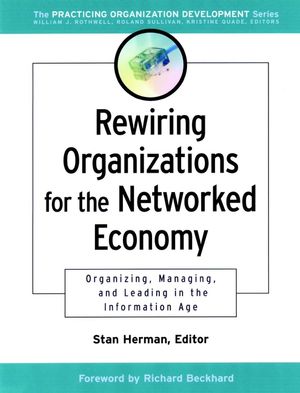Rewiring Organizations for the Networked Economy: Organizing, Managing, and Leading in the Information AgeISBN: 978-0-7879-6065-0
Paperback
240 pages
March 2002, Pfeiffer
 This is a Print-on-Demand title. It will be printed specifically to fill your order. Please allow an additional 10-15 days delivery time. The book is not returnable.
|
||||||
Foreword to the Series.
Introduction to the Series.
Statement of the Board.
Dedication.
Acknowledgments.
Preface.
Part I: Setting the Stage.
1. From Prediction to Emergence :A New Fundamental (StanHerman).
Uncertainty Is Unavoidable.
Technology and Commerce Are the Key Driversof OrganizationChange.
Three Imperatives of Change Derived from InformationTechnology.
Part 2: The New Strategic Basics.
2. Strategic Navigation:Learning Viabilityin a World Wired forSpeed (Richard Hames).
Prerequisites for Viability.
Living Systems.
Viability Questionnaire.
Strategic Navigation.
Learning Your Way Forward.
3. Strategic Conversations in the Networked Economy (BillBruck).
Technology-Mediated Conversations.
The Changing Role of Change Agents.
Strategic Conversations Are Technology Conversations.
Conclusion.
4. Inside the AOL Experience (Mary E.Foley).
Creating Hypergrowth Results.
Characteristics of AOL s Results-Oriented Culture.
Ambiguous Results or Results in Ambiguity?
AOL: A Hypergrowth Anomaly?
Getting a Clue.
Part 3: Collaborative Challenges.
5. Virtual Teamwork (Jeremy S.Lurey).
Critical Success Factors for Virtual Teams.
The Importance of Executive Sponsorship.
Domestic Versus Transnational Virtual Teams.
Implications for Improving Virtual Team Effectiveness.
Conclusions.
6. Ready for Virtuality: A Case (Carol Willett).
What Is a Virtual Team?
A Case in Point: Teams at DOE.
Summary.
7. The Whole System Transformation Conference:Fast Change for the21st Century (Roland L.Sullivan,Linda K.Fairburn,and WilliamJ.Rothwell).
The Challenge: A Universe Undergoing Substantialand AstonishingChange.
Whole System Transformation Conference.
The Whole System Transformation Conference Model.
Conceptual Framework and Underpinning Philosophy.
Conclusion.
Part 4: HR,OD,and Information Technology.
8. Basic Info-Tech for Consultants (Perry Nelson).
Master the Use of E-Mail.
Use the Internet.
Learn About and Experience Participating in OnlineConferences.
Establish a Presence for Yourself on the Web.
Tips for Getting Up to Speed and Keeping Up withDevelopments.
9. HR and IT:Metamorphosis and Opportunities (JanaMarkowitz).
Technologies Begin to Blur the Lines.
Telecommuting.
E-Learning.
Knowledge Management.
E-Cruiting: Internet-Based Recruiting.
Approaches to HR/IT Integration.
Should a New Economy Company Even Have an IT Organization?
Conclusion.
Part 5: Conclusions and Implications.
10.Re-Evaluating Our Values for a Better Fit (Stan Herman).
Ideal Values.
New Theories.
Helpful or Heretical?
Expanding and Extending Perspectives.
About the Editor.
About the Series Editors.
Index.
Introduction to the Series.
Statement of the Board.
Dedication.
Acknowledgments.
Preface.
Part I: Setting the Stage.
1. From Prediction to Emergence :A New Fundamental (StanHerman).
Uncertainty Is Unavoidable.
Technology and Commerce Are the Key Driversof OrganizationChange.
Three Imperatives of Change Derived from InformationTechnology.
Part 2: The New Strategic Basics.
2. Strategic Navigation:Learning Viabilityin a World Wired forSpeed (Richard Hames).
Prerequisites for Viability.
Living Systems.
Viability Questionnaire.
Strategic Navigation.
Learning Your Way Forward.
3. Strategic Conversations in the Networked Economy (BillBruck).
Technology-Mediated Conversations.
The Changing Role of Change Agents.
Strategic Conversations Are Technology Conversations.
Conclusion.
4. Inside the AOL Experience (Mary E.Foley).
Creating Hypergrowth Results.
Characteristics of AOL s Results-Oriented Culture.
Ambiguous Results or Results in Ambiguity?
AOL: A Hypergrowth Anomaly?
Getting a Clue.
Part 3: Collaborative Challenges.
5. Virtual Teamwork (Jeremy S.Lurey).
Critical Success Factors for Virtual Teams.
The Importance of Executive Sponsorship.
Domestic Versus Transnational Virtual Teams.
Implications for Improving Virtual Team Effectiveness.
Conclusions.
6. Ready for Virtuality: A Case (Carol Willett).
What Is a Virtual Team?
A Case in Point: Teams at DOE.
Summary.
7. The Whole System Transformation Conference:Fast Change for the21st Century (Roland L.Sullivan,Linda K.Fairburn,and WilliamJ.Rothwell).
The Challenge: A Universe Undergoing Substantialand AstonishingChange.
Whole System Transformation Conference.
The Whole System Transformation Conference Model.
Conceptual Framework and Underpinning Philosophy.
Conclusion.
Part 4: HR,OD,and Information Technology.
8. Basic Info-Tech for Consultants (Perry Nelson).
Master the Use of E-Mail.
Use the Internet.
Learn About and Experience Participating in OnlineConferences.
Establish a Presence for Yourself on the Web.
Tips for Getting Up to Speed and Keeping Up withDevelopments.
9. HR and IT:Metamorphosis and Opportunities (JanaMarkowitz).
Technologies Begin to Blur the Lines.
Telecommuting.
E-Learning.
Knowledge Management.
E-Cruiting: Internet-Based Recruiting.
Approaches to HR/IT Integration.
Should a New Economy Company Even Have an IT Organization?
Conclusion.
Part 5: Conclusions and Implications.
10.Re-Evaluating Our Values for a Better Fit (Stan Herman).
Ideal Values.
New Theories.
Helpful or Heretical?
Expanding and Extending Perspectives.
About the Editor.
About the Series Editors.
Index.



